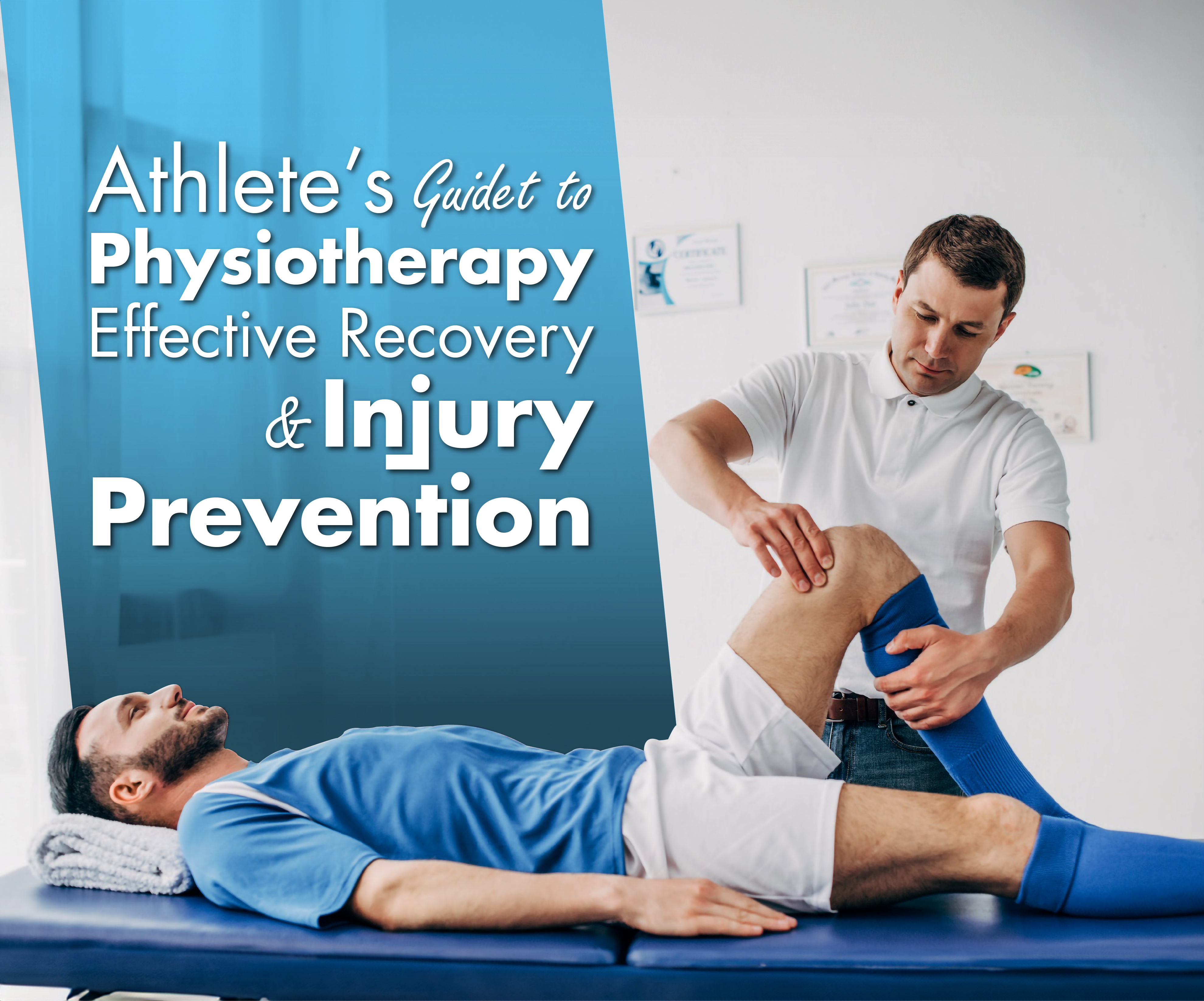Welcome to the Research and Strategy Services at in today's fast-paced.


In the rapid pace of the sports industry, everything, every second aspect, matters. Athletes continuously push boundaries so that they can train harder and break their former bests while competing with others as part of a deal. With that rigor comes the inevitability of injury, overuse, and burnout.
For all athletes, it is lucky that they do not have to assume such risks without aid or support. Physiotherapy is not just an important aspect in an athlete journey, it is more than recovering from an injury. It is even considered an integral part of the process, recovering smartly, and reducing risk of injury, while assisting athletes with overall performance as well.
Physiotherapy is a method of managing an injury, yet it is also a proactive approach to being more strategic about your health as an athlete. Physiotherapy is knitted into your training and is designed to help you, as an athlete, optimize your movement patterns, restore balance, build strength, reduce pain, and, most importantly, recover better and play longer. Ultimately, physiotherapy equals more training, more playing, and ultimately, health.

Physiotherapy is a science-based process that optimizes movement, improves strength, and maximizes function, both physically and overall. It has an individual and hands-on component that includes techniques, rehabilitation and prevention exercises, and equipment to help the general public and elite athletes once injured.
For the athlete, physiotherapy goes beyond rehabilitation of injury. The physiotherapy process will be individualized and personalized for you, with the goal of assisting your body in meeting the needs and demands of your sport to the highest standard.
Why Is Physiotherapy Important for Athletes?
Regardless of being a professional athlete or not, your body has to endure a lot of stress. Regular, repetitive movements, force, or sports with impact create certain wear and tear on your muscles, joints, and bones.
That is where physiotherapy comes into play. In addition to improving your capacity to recuperate from injuries, physiotherapy may also assist you in avoiding and preventing injuries in the future. Physiotherapy, specifically physio Pathy, is your best solution for injury prevention or injury management, for two reasons:
1. Physiotherapy will fully assess you as a mover.
2. Physiotherapy will analyse your weaknesses and imbalances and then be the ideal profession to help resolve issues before they escalate.
Benefits of Physiotherapy for Athletes
• Faster recovery from both new and ongoing injuries
• Increased mobility and flexibility
• Improved strength and balance
• Better movement efficiency and mechanics
• Less reliance on medication or surgery
• Reduced injury risk through proactive care
Every sport imposes unique physical burdens on the body, which consequently results in particular injuries being more common. When you're sprinting down the field, lifting in the gym, or swinging a racquet, your body is under a load. And sometimes when your body is under a load, it becomes injured. Most of these injuries can certainly be rehabilitated or treated in a physiotherapy clinic or rehab clinic, based on the clinical equipment.
• Sprains and ligament injuries (e.g., ACL or MCL injuries), often seen in high-impact, federal, or pivoting sports
• strains to muscles (e.g., hamstring strains, groin strains, or calf strains), occurring generally due to quick pivots or overuse
• injuries to tendons (e.g. Achilles tendinopathy, or tennis elbow), which relate to non-repetitive strain/assisted mechanics, Shin splints and/or stress fractures, which are common in marathon runners, sprinters, and those who jump a lot or do high-impact activity
• Shoulder injuries, whether tears of their rotator cuff or dislocations, again motivated by either the angle of their limb through functional movement requiring shoulder horizontal abduction or hyper-abducted limb through the functional shoulder movement
• Chronic back and neck pain (poor posture, muscle imbalances, athlete fatigue, etc.)
• Rehabilitation: acute post-surgical rehabilitation (i.e., ACL reconstruction, shoulder surgery, etc.) Pooled to guided injuries.
Returning to play too soon can be a dangerous prospect. If you go back to play too soon, you risk a bigger injury or a permanent injury. A carefully staged return to play program with a physiotherapist ensures you return at the right time and at the right level to rebuild strength, and regain appropriate function.
Comprehensive Assessment: The First Step in Your Return to Play Protocol
Every course of recovery begins with a comprehensive assessment, when your physiotherapist will:
• Evaluate your injury and pain levels
• Examine how you move
• Test your strength and mobility
• Evaluate athletics-specific function (e.g., sprinting, jumping again, pivoting)
• This is a holistic evaluation to assist your physiotherapist in developing a rehabilitation program specific to your sport, position, and goals. Your Custom Roadmap Back to Play No two athletes are the same; therefore no two treatment plans should be the same.
• Physiotherapy for athletes means your treatment plan will be designed specifically for you. This can include:
• Hands-on techniques to loosen stiff joints or tight muscles
• Strength training to rebuild lost muscle
• Balance and agility drills
• Sport-specific exercise to promote return to function
• A clear, step-by-step return-to-play progression
Getting better is great, but staying better is the ultimate goal. Physiotherapists work with athletes to fix movement issues that caused the injury in the first place. This often involves:
• Correcting muscle imbalances
• Improving flexibility and joint stability
• Building core strength
• Teaching smart load management
• Educating on posture and technique
Your physiotherapist may use some of the following techniques, depending on your needs:
• Manual therapy, which involves a joint mobilization or soft tissue release
• Dry needling or trigger point therapy that releases tight muscles
• Kinesiology taping that supports movement and reduces pain
• Electrotherapy (i.e., TENS, ultrasound) that addresses pain and/or inflammation
• Cryotherapy or heat therapy
• You may also be given corrective exercises to retrain movement patterns.
All of the above will form a comprehensive physiotherapy paradigm to treat your symptoms and address root causes.
Rehab isn’t just rest; it’s active. Your physiotherapist will guide you through exercises such as
• Mobility drills to improve joint range
• Strength training to rebuild muscle power
• Balance and proprioception exercises for control and coordination
• Sport-specific movements to get you game-ready
• Core and posture training to support overall mechanics
You’ll also be given at-home programs to maintain progress between sessions.
Expect your session to include:
1. A check-in on symptoms and performance
2. Hands-on therapy or techniques
3. A supervised workout targeting your rehab goals
4. Pain relief strategies if needed
5. Education on proper technique and recovery
6. Updates to your home routine
Each session builds on the last, adjusting as your body heals and adapts.
Don’t wait until things get worse. Athletes should see a physio if they:
• Have nagging pain, tightness, or stiffness
• Just had an injury or surgery
• Are not performing at their best
• Feel restricted in movement
• Want to stay one step ahead of injuries
Often during active rehabilitation, it may be up to 2-3 times per week. However, after symptoms have improved, athletes will frequently move to a more customary maintenance visit every couple of weeks or per month for peak performance.
Many athletes turn to physiotherapy not just to heal but to excel. Here’s how it helps:
• Improves muscle activation and control
• Optimizes movement patterns for better efficiency
• Helps avoid burnout and micro-injuries
• Supports smoother, stronger movement
• Aligns the body for peak energy use
This is why comprehensive physiotherapy solutions are part of every top athlete’s toolkit.
Prevention is better than cure. Physios can detect small problems before they become big ones. Preventative care includes:
• Screening for weak spots
• Analysing how you move
• Providing targeted exercises
• Teaching proper recovery techniques
• Helping balance your training load
More athletes are building physio directly into their training calendar. It can be used during:
• Pre-competition warm-ups
• Off-season prep
• Recovery days
• Cross-training or rest cycles
This consistent approach keeps the body tuned, balanced, and ready to perform.
Sometimes it’s the little changes that make all the difference. Your physio might suggest:
• Cutting back slightly on training volume
• Switching up movements to reduce repetitive strain
• Improving sleep and nutrition
• Introducing foam rolling or recovery boots
• Fine-tuning posture or lifting technique
Each sport demands something different. That’s why physiotherapy designed for athletes is so specialized:
• Track & Field: Explosiveness, hamstring care, gait analysis
• Swimming: Shoulder mobility, spine alignment
• Basketball/Football: Jump mechanics, knee and ankle support
• Martial Arts: Flexibility, core strength, quick reactions
• Cycling: Lower back strength, pelvic stability
• Golf/Tennis: Rotational power, grip, and wrist strength
Injuries may affect you physically as well as mentally. You may feel angry, anxious, or fearful. Physiotherapists can also assist with the mental side of your recovery by providing motivation, help, and support to get you through your injury.
How you perceive recovery shapes your outcomes. When you have a clear focus and a targeted mindset, it's easier to be consistent, motivated, and realistic. Your physiotherapy team will likely promote the following concepts:
• Setting goals.
• Implementing visualization strategies
• Being patient through the plateaus
• Celebrating milestones throughout your recovery process.
The best recoveries happen with a strong support team. Surrounding yourself with coaches, teammates, physios, family, and mental health experts ensures you’re not just healing—but thriving.
Physiotherapy offers practical solutions to your pain, recovery from injuries, or improved performance. Full-range physiotherapy considers a symptom again and builds a better foundation to succeed for the long run.
Recovery takes time. So does greatness. But with physiotherapy designed for athletes, you get the right guidance, tools, and strategies to return to your sport smarter, stronger, and more confident than ever.
Physiotherapy is not just rehabilitation: it is a vital aspect of your success. If you incorporate physiotherapy into your training and your lifestyle, you create the best environment to perform well, limit injuries, and ultimately play longer and healthier sports.






Welcome to the Research and Strategy Services at in today's fast-paced.

Learn about a new multidimensional pilot study to comprehensively protect athletes from concussions.

Discover effective support strategies for keeping ADHD children engaged.

Learn why healthy aging is about more than just physical wellness.
.png)